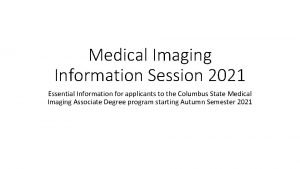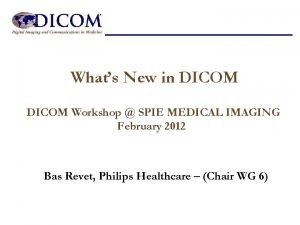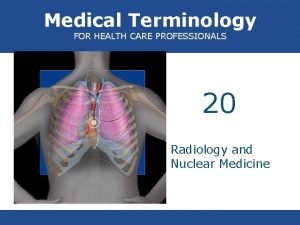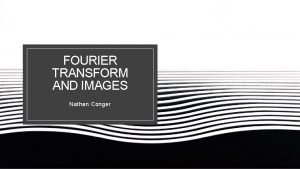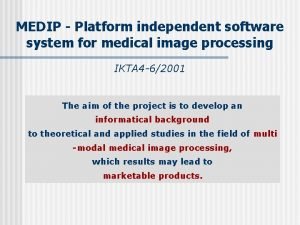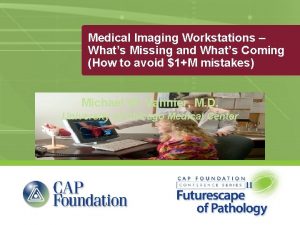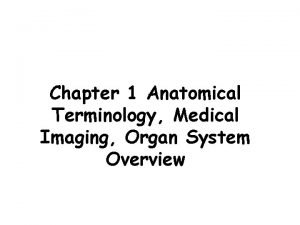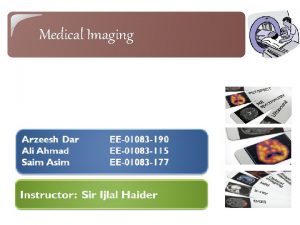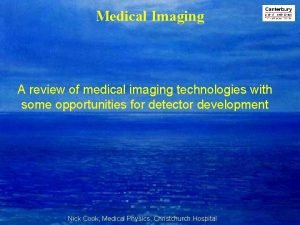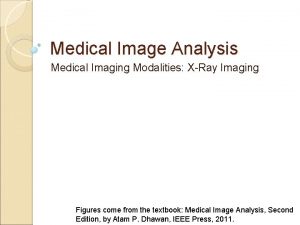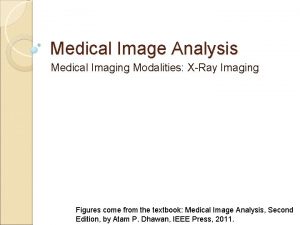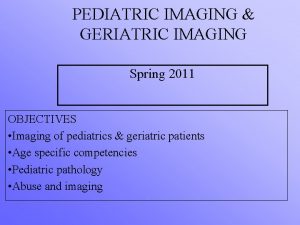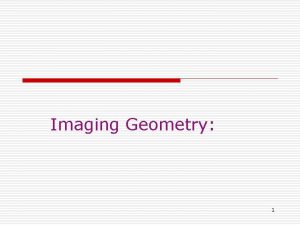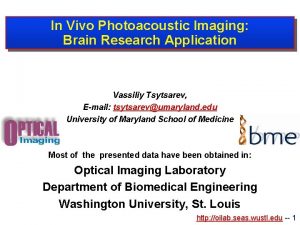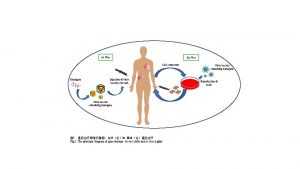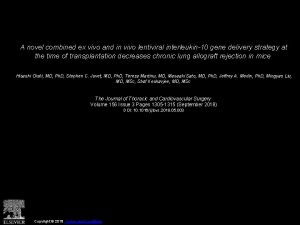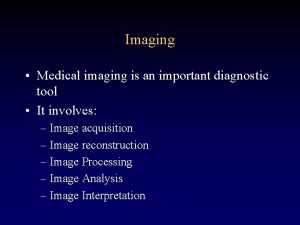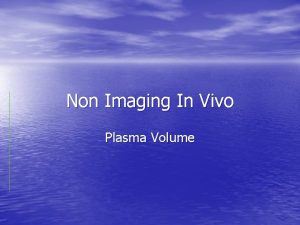In vivo imaging NIHRoadmap for Medical Research New






















- Slides: 22

In vivo imaging

NIH:Roadmap for Medical Research ・New Pathway to Discovery ・Research Team of the Future ・Re-engineering the Clinical Research Enterprise FDA:Critical Path Initiative(2004) ・effective application of basic researches to clinical researches ・combination of drug discovery, diagnostic and therapy NIH/NCI:Cancer Imaging Program (CIP) UK Clinical Research Collaboration promotion of clinical research National Biomanufacturing Centre Development of bio-drugs EMIL (European Molecular Imaging Lab. ) Network of researchers on cancer research Di. MI (Diagnostic Molecular Imaging) Research network of bioimaging

In vivo imaging technologies X-ray Computer Tomography (CT) Positron Emission Tomography (PET) 18 F, 11 C, 124 I, 64 Cu etc Single Photon Emission Computer Tomography (SPECT) 201 Tl, 67 Ga, 99 m. Tc etc Magnetic Resonance Imaging (MRI) Gd 3+ Complex, SPIO Fluorescence imaging (near IR) Luminescence imaging (Bioluminescence) Ultrasound imaging Light scattering imaging

X-ray CT X-ray source and detector are rotated around the subject of examination. During the permeation of irradiated X-ray into the subject, part of the X-ray is absorbed and the attenuated X-ray is detected. This absorption depends on a contents of the subject. Image is created with Fourier transform of this attenuated rate detected in 360°direction

Ⅹ-ray CT contrast agent Monomer type Dimer type Lipid type Lipiodol (Iodized poppy oil)triglyceride

SPECT Detect g-ray emitted from RI-probe administered in body woth g-camera and its tomographic image is made. Detection of early phase in atherosclerosis, heart diseases or cancers Easy to handle, but the sensitivity and resolution are lower than PET due to the absorption of g-ray in the body.

SPECT contrast agent 99 m. Technetium (99 m. Tc)examethadim: (99 m. Tc-HMPAO) For brain functional imaging The absorption depends on the blood flow.

Positron Emission Tomography (PET) Detection of metabolic level in central nervous system or tumor Half life 15 O: 2 min, 13 N: 10 min, 11 C: 20 min, 18 F: 110 min The collapse of above atoms emits one positron. The positron gets pair annihilation with water molecule and emits two photon (511 ke. V)to opposite direction. Then the two photons are detected with photomultipliers set around the object. If two photons are detected at the same time in opposite direction, radiation source should exist in the line. X-ray CT PET

Tumor imaging using 18 F-Fluorodeoxyglucose Cancer cell 18 FDG P × metabolism

Magnetic Resonance Imaging (MRI) Detect of magnetic relaxation in water proton Contrast agent using dipole-interaction H O H Gd-DTPA (Diethylenetriamine-N, N, N’, N” -pentaacetic acid) complex ・ Contrast agent using magnetic susceptibility > 100 nm Ferric oxide Fe 3 O 4 paramagnetic Superparamagnetic positive contrast negative contrast T 1 -weighted spin-echo T 2*-weighted gradient-echo

Decrease of osmotic shock Gd-DTPA (Magnevist) Gd-DTPA-BMA Gd-DTPA-BMEA Gd-DOTA Gd-HP-DO 3 A Gd-DO 3 A-butrol

Accumulation in hepatocyte Gd-EOB-DTPA Gd-BOPTA

High sensitivity-type Gd-DTPA pendant polymer Poly-ion complex type Gd-DTPA pendant dendrimer Gd-complex adsorbing to albumin

Micelle type:atheroma, cancer Gd-AAZTA-C 17 Micell forming Gd-DOTA (Gd fluorine) PAMAM dendrimer Gd-DO 3 A-diph bind to LDL Gd-DO 3 A-diph アビジンと結合して巨大複合体 EPR効果でがんに蓄積

ミセル型造影剤:アテローム、がん Gd-AAZTA-C 17 Micell forming Gd-DOTA (Gd fluorine) PAMAM dendrimer 4 -8 Gd-DO 3 A-diph Bind to LDL Gd-DO 3 A-diph

Functionalized Contrast Agents + Imaging unit Molecular probe Sensing unit Functionalized Contras Agents 1: for endothelial injury or disorder using dye molecule 2: for cancer cells using sigma receptor-specific ligand

Ligand-conjugated type Glutamine transporter -binding HT-DOTA-Gd Macrophage targeting Myeloperoxidase binding

Enzyme substrate-type esterase Water insoluble: MRI silent Water soluble: MRI signal on Esterase-responsive system b-galactosidase b-Galactosidase-responsive system

Contrast agent for endothelium damage

Screening of dyes with specific adsorption to endothelium damage Evans Blue: 10 mg/ml Thioflavin T: saturated Crystal Violet: saturated Congo Red: 10 mg/ml Primuline: saturated Trypan Blue: 10 mg/ml Sirius Red: 10 mg/ml

Balloon treatment + EB-DTPA-Gd Before administration aorta 60 min after administration the Normal + EB-DTPA-Gd Before administration 60 min after administration the Balloon treatment + Gd-DTPA Left: normal aorta Right: injured aorta Before administration 60 min after administration the

Detection of arteriosclerosis Spasm occurs in atheloma Detection of atheroma
 Frc control system
Frc control system Ohiohealth berger hospital mammography circleville
Ohiohealth berger hospital mammography circleville Spie
Spie Radiology medical terminology
Radiology medical terminology Fourier transform in image processing
Fourier transform in image processing Medical imaging software
Medical imaging software Medical imaging workstations
Medical imaging workstations Manus region
Manus region Fspos vägledning för kontinuitetshantering
Fspos vägledning för kontinuitetshantering Typiska drag för en novell
Typiska drag för en novell Nationell inriktning för artificiell intelligens
Nationell inriktning för artificiell intelligens Ekologiskt fotavtryck
Ekologiskt fotavtryck Varför kallas perioden 1918-1939 för mellankrigstiden?
Varför kallas perioden 1918-1939 för mellankrigstiden? En lathund för arbete med kontinuitetshantering
En lathund för arbete med kontinuitetshantering Personalliggare bygg undantag
Personalliggare bygg undantag Personlig tidbok fylla i
Personlig tidbok fylla i Sura för anatom
Sura för anatom Vad är densitet
Vad är densitet Datorkunskap för nybörjare
Datorkunskap för nybörjare Tack för att ni lyssnade bild
Tack för att ni lyssnade bild Mall debattartikel
Mall debattartikel Magnetsjukhus
Magnetsjukhus Nyckelkompetenser för livslångt lärande
Nyckelkompetenser för livslångt lärande

